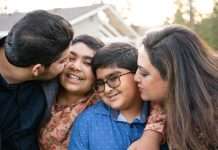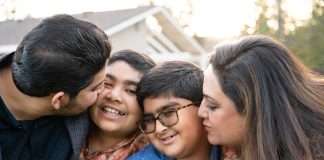Mom, what is happening here?
Chances are, if your child had ever come across a newscast, they would be curious to know what they were seeing. When answering questions about terrorism, tragedy, or the like for children, it’s important to remember that each answer must take a child’s age, developmental level, and emotional maturity into consideration. Therefore, very young children, or those who for whatever reason, have not developed the intellectual or emotional skills to understand these fairly abstract concepts should be protected from talking openly about them. Instead, parents should focus on talking about what they have done and will continue to do to keep them and their homes safe.
When talking with children who are old enough to understand abstract concepts to some degree, it’s helpful to start with short explanations using concrete terms and simple analogies and move toward open, honest discussions including questions that encourage thought and offer tips for how to stay safe. Also, taking steps to limit the amount of information kids are getting from social media or news outlets that focus on sensational images and dramatic, often unconfirmed stories, is important.
How do we define terrorism vs. tragedy with children?
Terrorism refers to violence against a group of people for the purpose of accomplishing some sort of political goal and generating terror in people. This is why, in some cases, terrorists target civilians and not military groups.
A tragedy refers to an event that causes significant suffering and distress such as a severe accident, a significant loss, a crime, or a natural disaster. Tragedies often affect a large group of people at one time such as in the case of a tornado that destroys much of a town. However, a tragedy can be experienced by just one person, such as when a person is the victim of a violent crime.
When defining terrorism vs. tragedy with children, parents can talk about a true act of terrorism being a tragedy but also explain that not every tragedy is an act of terrorism. It’s important for kids who have abstract thinking skills to understand the distinction that terrorism is related to accomplishing political goals and that they are unlikely to be able to prevent terrorism but they may be able to prevent being a part of a tragedy. In other words, sometimes a tragedy that a young person experiences may be the result of making a poor choice or taking a dangerous risk.
How do we talk about war with our children?
It can be helpful to talk about previous wars and why they were fought. Parents can be honest about some of the lessons that have been learned about the practice of war. While it’s best not to focus on any troubling details of wartime trauma until kids are preteens, teens, or emerging adults, it is important for children to learn that war does cause death for many men and women who fight in wars.
How do we help them understand what happened and why?
Often, it’s hard for parents to understand why a particular act of terrorism or a tragedy occurred and it is ok to say, “I don’t know.” You can use your confusion to teach children about the importance of not drawing conclusions about an event until evidence-based facts have been presented by reputable sources. Present facts as you have them without adding your opinions and while waiting to obtain more information, talk about the truth that sometimes human beings do things to hurt and kill other people.
For older kids who are able to hear and consider the complexities of acts of terrorism or tragic events, talk about the facts and implications in small discussions, leaving plenty of time for them to ask questions and for you to respond honestly. Teach them how to recognize behaviors in others that may indicate some potential violent behavior, who to report that behavior to, and how to protect themselves.
How do we explain why some people hurt others?
While there are some people born with conditions that may contribute to their desire to hurt others, in the vast majority of cases, people who hurt others have been hurt themselves or taught to hurt others in order to protect themselves. Some who hurt others may rationalize their behaviors as justified in order to get something they want, to seek revenge or in defense of a perceived danger.
Children of all ages need to understand that violence is not an effective way to manage conflicts with other people. This opens an opportunity to teach children effective conflict management skills, emotional regulation, and how to ask for help to avoid getting hurt.
How do we find the learning points from a circumstance where seemingly no one is in the “right”?
Explain that in the case of a specific circumstance, reasonable people can disagree and see the circumstance from different perspectives. This opens up the opportunity for people to learn from one another and to learn that often, there is not a right or wrong answer but rather several different potential answers. Let your children play out this concept when they differ from one another.
How do we reassure our children that they’re safe?
Listen to what they are concerned about and talk about specific steps you have taken or will take to try to provide safety. When you have done something to keep them and your home safe, tell them what you have done and why. If there has been a real threat to their safety at school or somewhere in their community, let them know that you and other adults are addressing the safety concerns. Make older children a part of the safety discussions.
Since parents cannot promise that their children will never be harmed, it is best for them to let their children know that they will do everything possible to keep them safe. It is also important to teach children to protect themselves as they become more independent.
How can we empower our children to “do the right thing”?
First, be good models of doing the right thing so they learn via your example. Also, point out the positive consequences of doing the right thing and the negative consequences of doing the wrong thing when you see those consequences in their lives or the lives of others.
____________________________________________________
About Joannie DeBrito, Ph.D.
Joannie is a licensed clinical social worker and licensed marriage and family therapist who is now working on the Counseling team as a Hope Restored Aftercare Coach. This role allows her to focus on helping couples have more meaningful relationships. As the former Director of Parenting and Youth at Focus and co-creator of the suicide prevention program, Alive to Thrive, Joannie continues to speak about suicide and other issues related to youth and young adult mental health. She is also available to talk about intentional Christian grandparenting. Joannie is a mother of two and grandmother of two and currently lives in Colorado Springs with her husband of nearly 45 years.
















